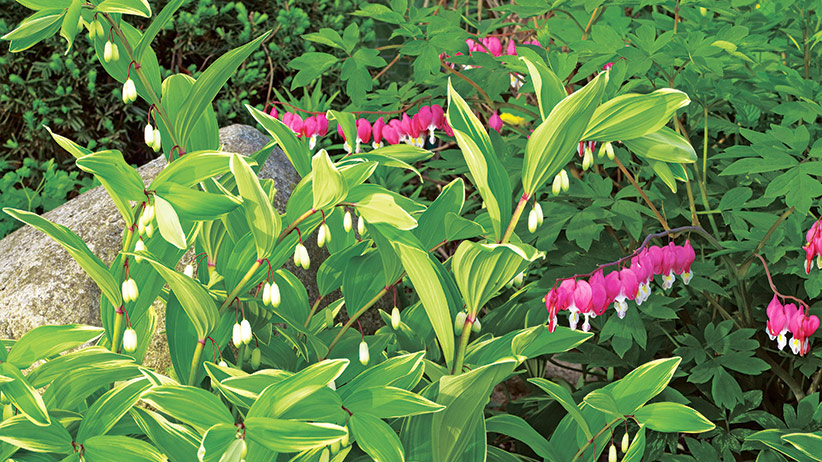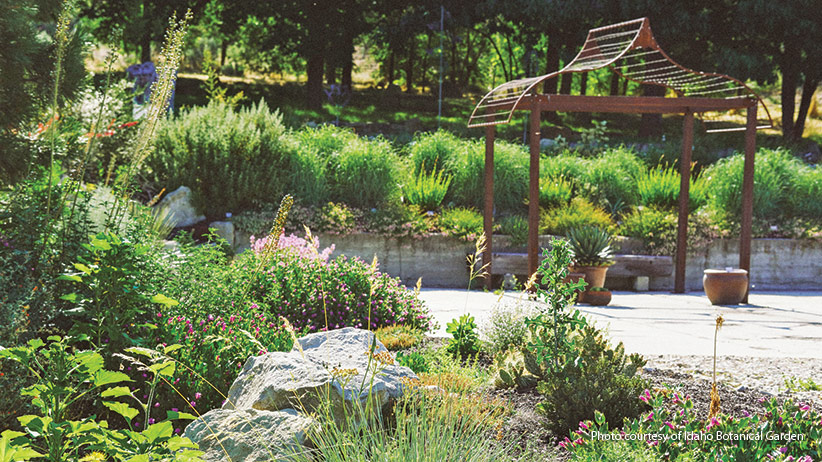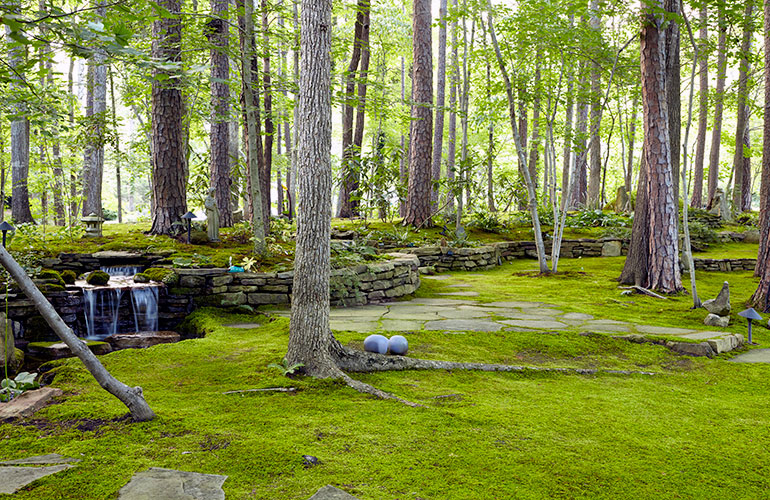
If you’ve hiked woodland trails, you’ve likely stopped in awe and knelt to get a closer look at mounds of moss growing on the forest floor. Moss is one of nature’s most low-profile plants. But its small stature makes it the most magical.
Moss is remarkable in its self-reliance: It requires neither fertilizers nor pesticides. It doesn’t have to be mowed or pruned. And it needs little water. It’s like a living green mulch. Mosses have been around at least 450 million years and are the oldest plants on land: They cushioned the feet of dinosaurs. And they are ubiquitous: Moss can be found on all seven continents.
David Spain, the moss man
David Spain lives in a moss paradise. The yard surrounding his home is a verdant moss garden, complete with water features (moss loves moist spots!) and a 10-foot-wide moss mound that is simply magical. The Raleigh, North Carolina, garden you see above is both test garden and homage to the wonders of moss.
David is a moss evangelist. “It is my passion,” he says. “I love this plant.” If you want a lawn in the shade, moss is boss.
Why is moss so great?
-
Moss is low-maintenance Because moss doesn’t have a root structure, it doesn’t need nutrients from the soil. Moss gets nutrients through its leaves — from rainfall and sunlight. This small plant doesn’t grow out of control or need mowing or pruning. It stays thick, dense — and short. Compared to other lawn options (we’re looking at you, turf grass), it’s totally carefree.
-
Moss is drought-tolerant Once it is attached and begins to spread, moss can survive on rainfall.
-
Moss will grow anywhere Moss takes up residency and spreads happily where no other plants will (or can): on stones, wood, soil, in deep shade. In areas where conditions are bad for grass, moss excels. Most mosses don’t care about soil pH.
-
Moss can take foot traffic You can walk, drive a car, or ride a bike across moss. Here’s why: Moss can be squished flat and it will bounce back. But because moss doesn’t have deep roots, it can’t take active movement: It will scratch up off the ground. David says backyard moss is not a good option for soccer-playing kids or ball-catching dogs.
-
Moss is winter-hardy Moss loves being covered by snow because it stays hydrated. Moss has a natural antifreeze in it and as soon as it defrosts, it comes out healthier thanks to the extra moisture. It’s an evergreen mulch. Moss is an ideal mulch alternative. It’s green, holds moisture, and helps retain the soil. Its spreading nature also helps suppress weeds. And like mulch, moss works as a design element, drawing in the eye and unifying an area.
You Might Also Like:
Designing with Japanese maples
How to make a kokedama
7 ways to use conifers in your garden
Drought-tolerant lawn replacements
Best Horseshoe Game Sets
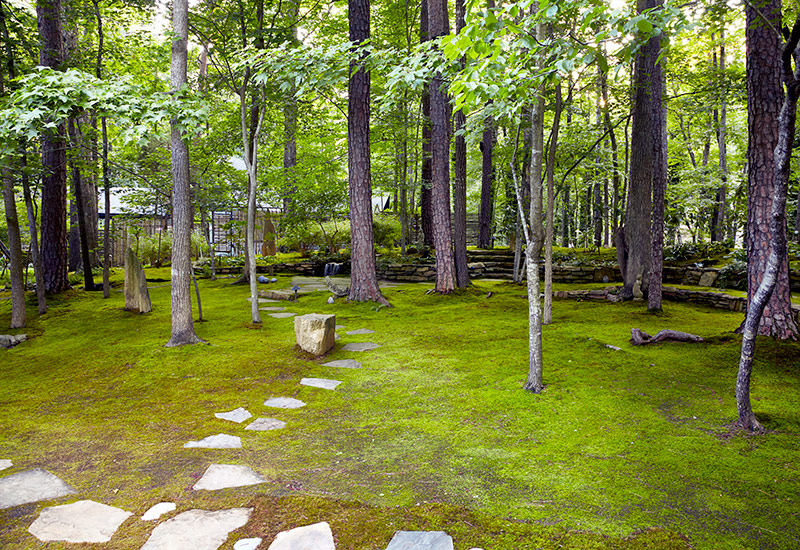
Moss as a lawn replacement
In this garden, moss is a lawn replacement; it grows happily under large trees where traditional turf grass can’t thrive. Growing also between stepping stones and alongside water features, the mosses create a uniform green look.
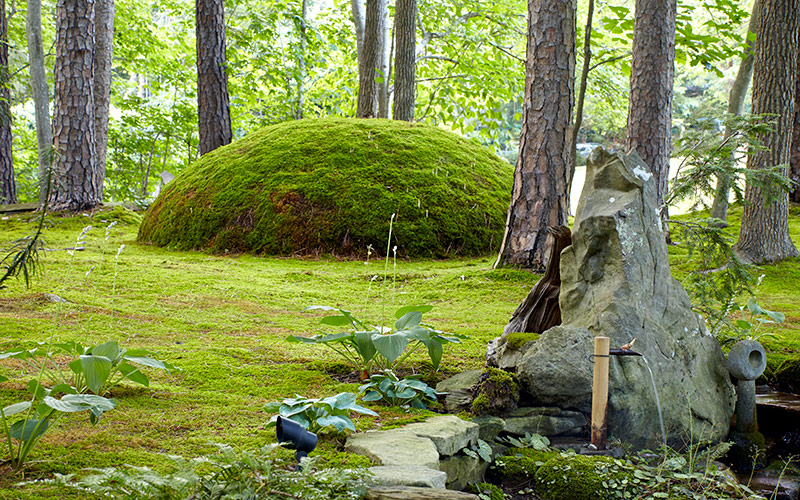
Use moss on more than flat surfaces
But David doesn’t just think in flat spaces. He uses the talents of moss to create multi-dimensional design elements in his yard, such as a 4½-foot-tall, 10-foot-wide mound in the photo above. It’s built with a cinderblock base for stability. Soil and wildlife netting give the moss a base to grow on the structure. From a landscape design perspective, the moss mound in the rear corner of his yard adds a verdant architectural element. Oh, and it’s also just plain magical.

Two types of garden moss
There are two kinds of garden moss: acrocarpous and pleurocarpous.
1. Acrocarpous moss
Acrocarpous mosses have a short upright growth habit. This type of moss produces foliage that is erect, unbranched, and forms a mounded colony. Weeds don’t have a chance of popping up in acrocarpous moss because it grows so thick and has tightly packed stems.
2. Pleurocarpous moss
Pleurocarpous mosses have a branching growth habit. This type of moss grows faster than acrocarpous moss, attaches to rocks, and does a better job of growing in rough ground. Pleurocarpous mosses also regenerate quickly from broken pieces, which makes them ideal for poking here and there amid rocks.
Planting and maintaining moss
David recommends planting acrocarpous and pleurocarpous mosses in separate areas in the yard because of their specific watering needs. Acrocarpous moss requires less water and takes longer to establish — 6 to 12 months. Faster attaching and spreading pleurocarpous mosses need regular hydration to establish themselves, taking just 3 to 6 months.
Adding moss to an area of your yard (or replacing your entire lawn) is easy. It just requires a clean slate on which to establish. That means clearing the planting area of leaves, branches and sticks. Scratch up the soil with a rake to make it smooth and moisten it. Then moisten the moss to make it pliable.
Tips for planting moss in your garden
- Pull moss sheets apart and place pieces firmly into the soil (walking on them helps). It’s like laying carpet squares!
- To help moss stay in place (while its rhizoids, hairlike structures that help moss make contact with the soil, are developing), David suggests pinning it in place.
- After the moss is planted, water it well based on the type. Once anchored in the soil, moss will start growing.
While mosses are establishing coverage, you may need to weed planted areas. Simply pull out interlopers until the moss is thick enough, like living mulch, to discourage weed seed germination. Note: Avoid taking moss from the wild. If you have moss growing on your property, you can harvest it with a spatula.
You Might Also Like:
Perennial deadheading guide
How to design with goldenrod in your garden
Shade garden plant combinations for hosta lovers
Plants for a gravel garden
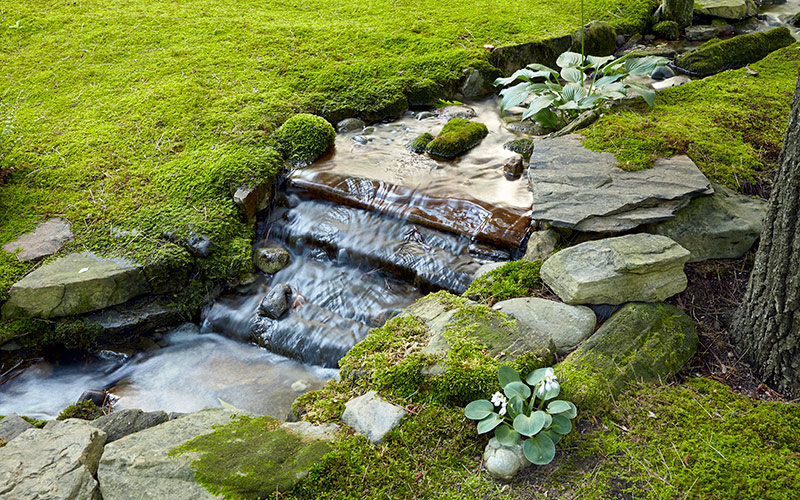
Best mosses for home landscaping projects:
Lawn replacements: Fern moss
Fern moss is a versatile pleurocarpous moss that grows on stone, concrete, wood and soil. It covers the moss mound in photo 1 and its strong woven branching growth habit makes a durable, walkable lawn option. It can withstand drought once established. Fern moss is also ideal for using around a water feature or as a living mulch in a garden. It does best in full shade to part sun and needs regular moisture for establishment (it spreads quickly with ample water).
Dry spots: Mood moss
Mood moss is an acrocarpous type that changes its look with different moisture levels. When dry, it is wispy and irregular. When moist, it sports a fluffy, textural demeanor, as in photo 4. If you have dry shade, this is the moss to use. It will grow on soil, stone, or wood, taking 6 months or more to establish. Mood moss is not a good choice in areas with regular foot traffic. Grow it in full shade to part shade. It needs minimal moisture to get established and is extremely drought tolerant.
Uniform surface coverage: Sheet moss
Sheet moss is pleurocarpous, low-growing, and interwoven, which creates a uniform surface. It’s like a carpet. With a medium growth habit and the ability to cover wood, soil and sometimes stone, this moss adapts to a wide range of conditions. Its strong woven branching growth makes for a durable walkable moss lawn. Grow sheet moss in full shade to part shade and give it regular moisture when newly planted. Once established, it’s drought-tolerant.
Whether you want a moss lawn or simply a Zenlike spot in your garden, moss offers a verdant, low-maintenance coverage option.
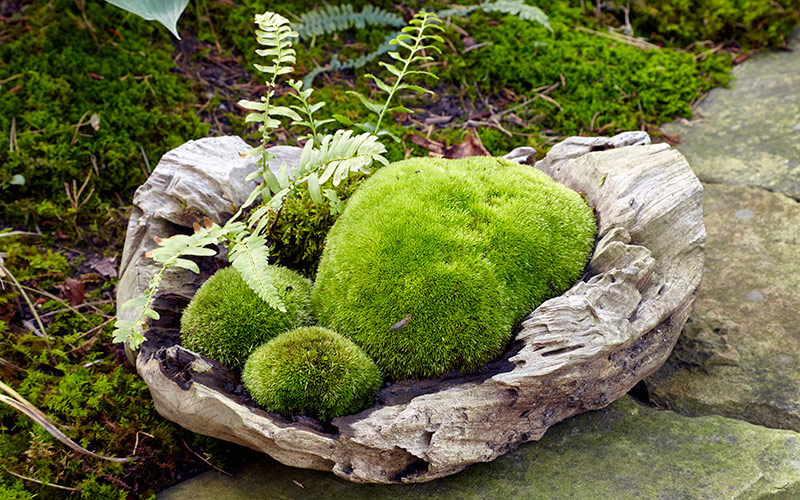
Tips for growing moss in containers
If you don’t have a spot for moss in your yard or garden, try it in containers. Here are some tips:
-
Choose an appropriate container Select pots made from moss-friendly mediums, such as plastic, ceramic, seasoned concrete, stone or wood. Avoid galvanized, zinc or copper containers — mosses are sensitive to heavy metals and some chemicals.
-
Facilitate drainage Use a container with ample drainage holes, add gravel to the base of the container and top with a well-draining potting medium.
-
Combine different moss types — and other plants Mosses with varying textures and shades of greens make good partners. Other moss-friendly plants include ferns, small hosta, mondo grass and miniature Solomon’s seal. Top off with organic décor Add a piece of wood or stone to complement the moss planting.










